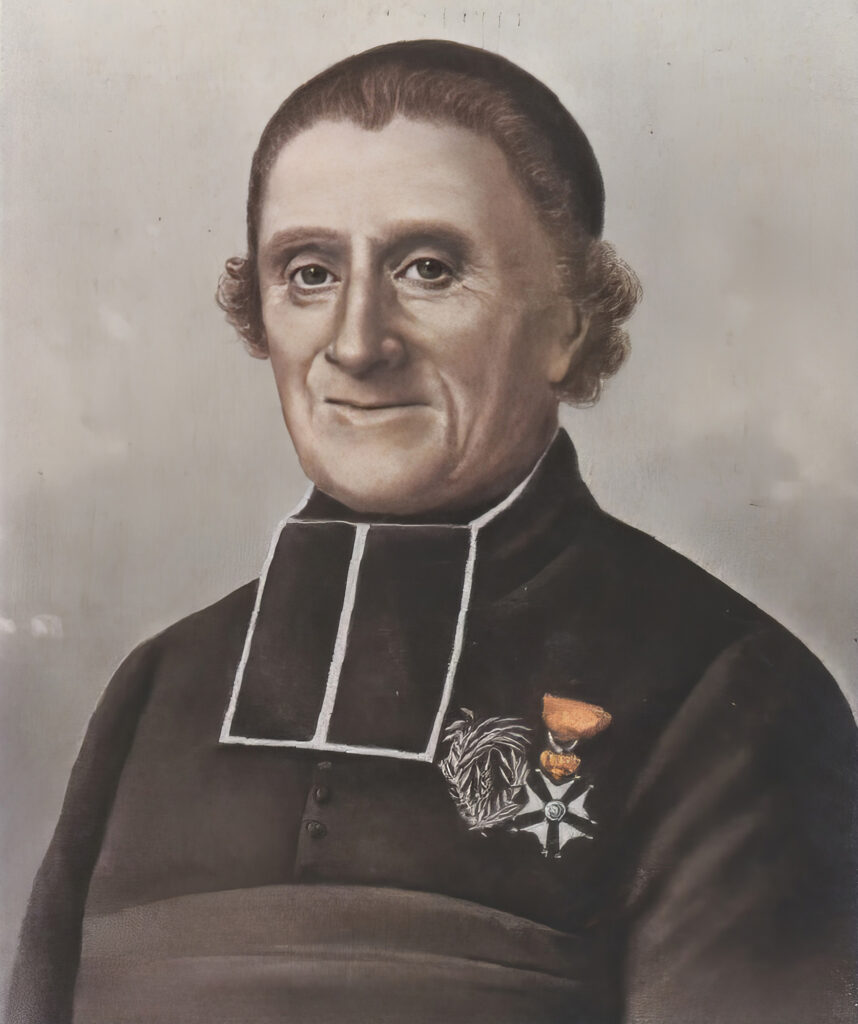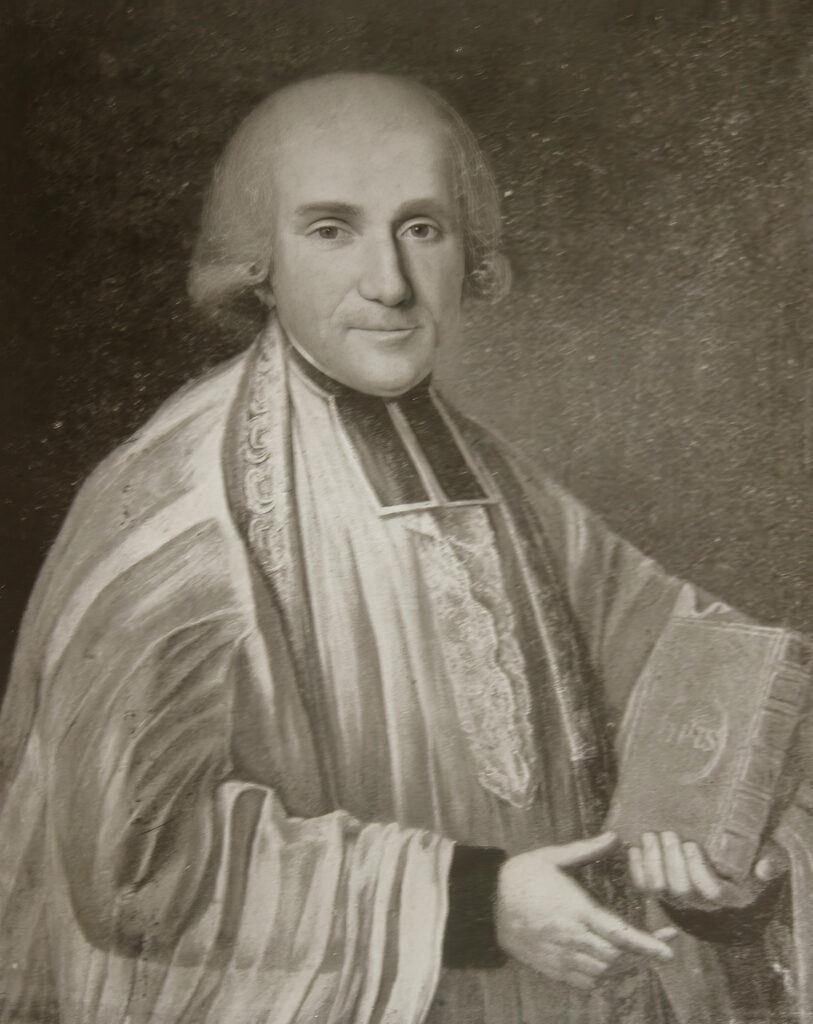Blessed Pierre-François Jamet (1762-1845) was a distinguished figure of the French clergy of the 19th century, renowned for his dedication to the most vulnerable and his unwavering spirit of commitment. His work transcended his era through a compassionate and innovative apostolate.
A childhood rooted in faith
Born on September 12, 1762 in Frênes (Normandy), Pierre-François Jamet grew up in a wealthy and devout family with eight children. His parents, fervent Catholics, instilled in their children values of charity and social justice. From a very young age, Pierre-François manifested a deep religious vocation. After studying at the Collège de Vire, in 1782 he entered the University of Caen to study theology and philosophy. He then entered the seminary of the Eudists in Caen, where he deepened his spiritual and pastoral formation.
On September 22, 1787, Pierre-François was ordained a priest. This period of peace marked the beginning of events that would transform France and test the strength of his faith.
Resilience and Courage during the French Revolution
When the French Revolution broke out in 1789, the young abbé Jamet was faced with difficult decisions. In 1790, he was appointed chaplain of the Sisters of the Good Savior of Caen, an institute dedicated to the care of sick women. However, the adoption of the Civil Constitution of the Clergy, which subjected the Church to the revolutionary authorities, deeply divided society. True to his principles, Pierre-François refused to take the oath, becoming a refractory priest. He went into hiding, exercising his ministry in secret and risking his life.
The Sisters of the Good Savior of Caen, a congregation of pontifical right founded in 1730 by a former novice of the Good Savior of Saint-Lô, Anne Le Roy (1692-1781), for the purpose of educating and assisting the sick in their homes. The institute was approved on July 28, 1735 by Bishop de Luynes and restored after the Revolution in 1805 by Pierre-François Jamet (1762-1845), who added psychiatric care and teaching for the deaf to its purposes. Today, the Institute no longer exists as such, but as an integral part of the Missionary Sisters of the Gospel, born on September 4, 2014 from the union of four institutes: The Sisters of the Good Savior of Caen, Sisters of Charity of Holy Mary of Angers, Sisters of Saint Charles of Angers and Sisters of the Holy Family of Nantes.
During these turbulent years, he organized night masses, administered the sacraments and offered spiritual support to the dispersed nuns and persecuted faithful. His courage and dedication earned him the admiration of the local Catholic community, but also the constant monitoring of the revolutionary authorities.
The restoration of the Sisters of the Good Savior
After the end of the Terror and with the religious pacification initiated by the Concordat of 1801, Pierre-François Jamet devoted himself to restoring the Institute of the Good Savior. In 1805, he acquired the former Capuchin convent in Caen, which he transformed into the motherhouse of the congregation. Under his direction, the Institute experienced a spectacular rebirth, strengthening its mission in favor of women suffering from mental disorders.
His commitment was not limited to the spiritual animation of the congregation. A visionary, Abbé Jamet oversaw the formation of the sisters and the people under their protection. In 1816, he opened a school for deaf-mutes, becoming a pioneer of special education. He developed innovative methods, such as teaching through sign language and lip-reading, giving deaf-mutes the opportunity to integrate into society.
The Institute also expanded its services, welcoming deaf patients of both sexes in conditions of dignity and respect unparalleled at the time. The holistic care promoted by Pierre-François Jamet foreshadowed modern approaches to psychiatry and social care.
Rector of the University of Caen
In 1822, Abbé Jamet was appointed rector of the University of Caen. His appointment came at a time when higher education was being reorganized in the wake of the revolutionary revolts. For eight years, he worked to revitalize the university, strengthening its academic programs and consolidating its role as a regional intellectual center. Despite his academic responsibilities, he never neglected his pastoral work, tirelessly exercising his ministry among the most disadvantaged.
Extension of the work in Albi
In his eagerness to extend the mission of the Institute of the Good Savior, Pierre-François Jamet traveled to Albi, where he hoped to establish a new community. His efforts culminated in 1834 with the foundation of a house of the Good Savior in the city. This project is testimony to his universal vision of charity and his desire to help the marginalized, regardless of their origin or place of residence.
Pierre-François Jamet, deeply dedicated to his ministry and committed to the glory of God, lived a life marked by total dedication to his religious vocation. Finally, at the age of 83, he died on January 12, 1845, exhausted by the weight of the years and the tireless effort of his mission.
Spirituality and legacy
Pierre-François Jamet’s spirituality is based on absolute trust in Providence, profound humility and unconditional love for others. For him, every human being, whatever his capacities or limitations, possesses an intrinsic dignity. His motto, “Serving God in the lowliest,” illustrates his commitment to the most vulnerable.
Beatified by Pope John Paul II on May 10, 1987, Pierre-François Jamet’s memorial is celebrated on January 12.
Blessed Pierre-François Jamet embodies faith in action. By his courage in the face of adversity, his determination to respond to the needs of the most disadvantaged and his innovation in special education, he has left an indelible mark on the history of the Church and society. His example remains a source of inspiration for those who aspire to serve with love and humility.
Chronology
September 12, 1762: Born in Frênes, on the farm of La Villière, son of Pierre Jamet, farmer, and Marie Busnot, his wife. His twin, Christophe, was born a few moments later. They were baptized on the 13th by Abbé Fétu, vicar of Frênes.
1777: Pierre, the first-born of the family, left the Collège de Vire to go to university, and his father solemnly declared that he was willing for one of his sons to continue studying. He placed a Latin grammar book on the table and declared that the one who got hold of it would be the chosen one. Little Jean won. Pierre-François made no secret of his desire to get hold of the book, which he did one night when it was under his little brother’s pillow. They decided that he would devote himself to his studies. His father Pierre, who was on vacation, gave him his first Latin lessons.
October 17, 1777: He was admitted to the 4th course at Vire, although he had only been practicing Latin for a few months. Although his classmates had two years more practice than him, in the second competition of the year he ranked among the best. This situation he maintained until the end of his studies, as confirmed by the numerous prizes he won.
With a cheerful character, but without sentimentality or mushy sentiments, he was a resolute man. His extraordinary facility for study left him time for other hobbies, such as music, horseback riding and even weapons. This little peasant, when he met the young gentlemen and bourgeois who attended the college, quickly acquired their tastes, although he was determined to become a religious before finishing his studies. He had his crisis of worldliness: he wore the French habit and the lace jabot, his hair curled and powdered.
October 9, 1782: He enters the University of Caen for two years of Philosophy and three years of Theology and stays in a bourgeois house.
September 18, 1784: Received the tonsure from Bishop de Cheylus, Bishop of Bayeux, in the Episcopal chapel.
September 22, 1787: Ordained to the priesthood in Rouen by Bishop Dominique de la Rochefoucauld. He enters the higher course of theology.
1789: Obtained bachelor’s degree in theology and began studying for licensure.
August 4, 1789: The National Assembly puts an end to the Feudal Regime.
November 2, 1789: The assets of the clergy are placed at the disposal of the Nation.
June 16, 1790: A decree of the Assembly suppresses all noble titles.
July 12, 1790: Civil Constitution of the Clergy.
November 24, 1790: Decree obliging the clergy to take an oath to the Civil Constitution, under penalty of prosecution.
At the end of 1790, he became confessor to the community of the Sisters of the Good Savior on rue d’Auge in Caen.
January 21, 1791: Refuses to take the oath to the Civil Constitution of the Clergy.
May 1791: A decree authorizes refractory priests to celebrate mass in private places.
May 25, 1791: Signs a declaration, with the university professors of Caen, reiterating his fidelity to the Pope and Catholic dogma.
September 2, 1791: He is arrested and tried by the Committee, after a new refusal to take the oath. But the Committee releases him on condition that he appears at the first convocation. He is helped and escorted home by the captain of the National Guard, Bellami, whose tutor he had been, and then returns to Frênes, where his parents have just bought the Frichetière estate from Monsieur de la Roque de Rochemont.
Around September 17, he returned to Caen at night and hid in the Good Savior for a year.
December 1791: Election of new bishops, consecrated by Talleyrand.
April 6, 1792: The Assembly forbids all religious habit.
May 27, 1792: Decree of the Assembly: refractory priests can be deported.
At the end of July 1792, warned that he was about to be arrested, he fled to Mondeville, to the house of his friend Cauvet, professor of Medicine at the university; then to Rocquencourt, to the house of Abbé Hubert, a friend of the Institute of the Good Savior, and finally to Frênes, by the back roads, dressed as a layman.
At the beginning of August 1792, he returned to Le Bon-Sauveur, but…
August 12, 1792, new warning: he hides in the city for three days, at a friend’s house, pretending to have taken a passage to England; then he takes refuge in the countryside, in a safe house.
August 16, 1792, in the morning, the community of Good Saviour is dissolved by the municipal officials, who put seals on it after having made an inventory of the furniture.
August 18, 1792, the Convention decrees the suppression of congregations and confraternities.
The sisters were expelled and dispersed, except for six of them who remained at the side of the mentally ill.
Pierre-François returned to Caen, where he was hidden by a pious friend, Madame Vincent, who sent him to Hérouville, to the safe house of the Onfroy family, who worked for a Protestant landowner. This was the last place they would look for a refractory priest. He lived in the quarries, where he moved his library, and from there he exercised, under many disguises, his work of helping persecuted Christians in the faith.
Madame Geneviève Onfroy took his letters, supposedly written from England and brought by mysterious ships, to Madame Vincent in Caen. She was in charge of distributing them.
In the “general list of emigrants,” the last known address of the Jamet brothers was Frênes. Their emigration was not recorded until October 9, 1793. However, Pierre Jamet had actually emigrated to Jersey.
September 4 to 16, 1792, massacres throughout France and in the prisons of Paris, directed against aristocrats, refractory priests and wealthy merchants.
September 17, 1792, he lives with Amice Durell in Saint-Hélier, in the company of M. Louvet de Montsecret, director of the Lycée Louis Legrand, and Harivel, curate of Entremont. Peter had been expelled from Proussy, where he was curate, on Easter Monday, at the same time as his parish priest.
In December 1792, he informed Madame Le Bidois, superior of Bon-Sauveur, of his whereabouts. He returned to Caen for Christmas, where he visited, confessed and placed the Blessed Sacrament before each group of nuns in the city, before returning to Frênes.
The manor house of La Frichetière and L’Hivernière, where Anselme Jamet lived, were safe havens full of hiding places. Despite numerous police visits, no one was ever found there. At night, the barn was transformed into a chapel, where mass was celebrated for trusted friends.
In early January 1793, on being discovered, he fled to Caen.
Until 1798, he moved from one hiding place to another around Caen, especially in Hérouville, celebrating night masses in barns, baptizing and marrying clandestinely. Among his numerous hideouts were:
- The Mondrainville hotel, in the house of the printer Le Roy.
- The Glatigny farm in Cléville, owned by the Pierre-Labrière family.
Pierre-François Jamet usually traveled on horseback. To avoid the police, he varied his disguises. He often passed himself off as a doctor, known as “Citizen Deschamps”, thanks to his studies that made him credible.
January 21, 1793, death of Louis XVI.
May 16, 1793, new inventory of the Good Savior.
At the end of July 1793, arrival of Robespierre accompanied by the Committee of Public Safety.
October 18, 1793, news of the execution of Marie Antoinette on October 16, 1793.
October 20, 1793, the Convention issues a decree condemning to death all priests subject to deportation who are in the territory of the republic, as well as those who give them asylum.
February 3, 1795, Father Pierre-François celebrates a baptism in a private home.
July 5, 1795, performs a baptism at Notre-Dame de Caen.
November 9, 1795, blesses a marriage at Notre-Dame de Caen.
December 4, 1795, he is in Hérouville, where he celebrates a baptism.
January 1, 1796, baptizes a child in a private home in Hérouville.
In 1796, while on his way to Frênes on horseback along the Harcourt road, he was accosted by two gendarmes who were looking for a man named Jamet, whose description they had. Pierre Jamet, keeping calm, said, “Citizen Jamet, I know him perfectly well. A moment ago I saw him pass along this road. He is not far away. You will catch up with him at once.” Then he spurred his horse and turned off on a side road.
February 3, 1796, celebrates a baptism in Hérouville.
August 18, 1796, performs two baptisms at Ranville.
September 4, 1797, 1,700 priests are imprisoned.
In 1797, a religious awakening began. Despite prohibitions, burials, processions, pilgrimages and masses were held in barns or inn rooms.
In 1798, although the situation seemed relatively calm, arrests of priests, returned emigrants and lay people continued, often accompanied by violence.
18 of Brumaire 1799 (November 9, 1799), Bonaparte overthrows the Directory. From this moment, it is no longer necessary to hide.
November 10, 1799, Pope Pius VI is exiled to France, to Saint-Cloud.
In April 1802, the Concordat was signed, giving the Church a juridical status.
On May 27th, 1802, Pierre-François Jamet, 39 years old, sent a petition to the prefect to benefit from the amnesty granted to the exiles.
June 19, 1802, his brother Pierre, who had emigrated to London in July 1796 and lived in extreme poverty, returns. He disembarks in Caen with 39 companions aboard “Le César”, captained by Charles Viel de Ouistreham.
June 21, 1802, he takes the oath before the prefect and returns to Frênes, where he lives under surveillance.
May 23, 1803, Mother Françoise Hamel was elected superior of the Good Saviour Institute.
October 10, 1804, Pierre-François Jamet bought the former Capuchin convent for 30,000 francs, although it was in ruins. A similar amount had to be raised to restore it.
May 22, 1805, the remaining 16 sisters finally gather at the new convent of the Good Savior.
April 7, 1814, in Caen comes the news of the proclamation of a new king: Louis XVIII, brother of Louis XVI.
March 21 to July 8, 1815, Napoleon’s return: the Hundred Days.
In 1816, Pierre-François Jamet took in a 12-year-old deaf-mute girl, sister-in-law of his brother Jean, at Good Saviour.
In 1817, he perfected his method of signing for the deaf and dumb.
June 21, 1817, he was appointed superior of the Ladies of the Hospice of Saint-Louis.
In May 1818, he gave public demonstrations at the Caen fair of his sign method.
In July 1818, he made another public demonstration before 1,200 people, including the bishop and the prefect.
At the beginning of 1819, the Good Savior already welcomed 22 deaf-mute students.
March 27, 1819, he was appointed superior of the Good Savior.
April 15, 1819, he asks his brother Pierre to replace him as chaplain.
April 27, 1820, he read before the Academy of Caen, of which he was a member, his “Memoir on the instruction of deaf-mutes”, which was published that same year.
January 1, 1821, he is named honorary canon of the cathedral of Bayeux.
On November 20, 1821, he presented his second memoir, of a technical nature.
September 22, 1822, he is proposed as rector of the Academy of Caen.
November 14, 1822, a royal order appoints him rector of the Academy of Caen.
December 10, 1823, obtained by royal decree the creation of a chair of commercial law.
At the end of 1823, the Good Savior houses 100 demented women and 70 demented men, 60 deaf-mutes and 40 boarders under 14 years of age, along with 115 free female students.
In 1824, the Good Savior had 125 nuns, 75 mistresses and 50 novices.
September 16, 1824, Louis XVIII dies.
At the end of 1824, he was received in audience by Charles X, to whom he asked for the reopening of a university of theology and medicine.
August 7, 1830, resigns as rector of the Academy.
In 1832, Mgr. Brault, Bishop of Bayeux, appointed to the Archdiocese of Albi, asked him to take charge of a school for about twenty deaf and dumb girls, founded by Abbé Treilhou, that was in a state of penury. This school would form the basis of the second Good Savior.
In 1834, he founded a hospice at Pont-L’Abbé-Picauville, in La Manche, on a plot of land generously donated to him by Madame Riou, née D’Aigneaux.
In 1835, he began to write his memoirs and the history of the Bon Sauveur, which he published in 1839/40 under the title “Annales du Bon Sauveur”.
September 5, 1840, he collapses in the pulpit, exhausted and ill, without ever fully recovering.
January 12, 1845, died at the age of 83, leaving a complex of almost 14 hectares in the heart of the city, consisting of more than thirty successive acquisitions, with about 600 insane patients.







0 Comments